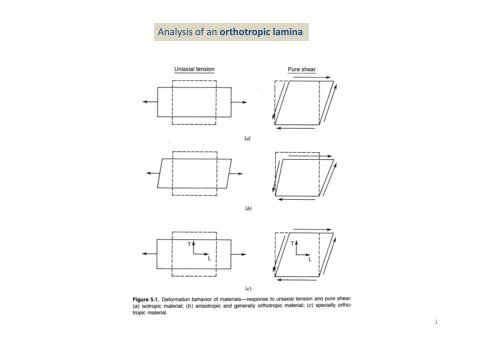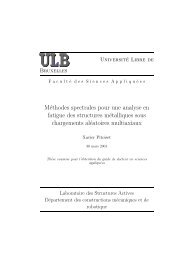Analysis of an orthotropic lamina
Analysis of an orthotropic lamina
Analysis of an orthotropic lamina
Create successful ePaper yourself
Turn your PDF publications into a flip-book with our unique Google optimized e-Paper software.
<strong>Analysis</strong> <strong>of</strong> <strong>an</strong> <strong>orthotropic</strong> <strong>lamina</strong><br />
1
Convention<br />
Equilibrium:<br />
Stress tensor<br />
dA 2=dA.n 2<br />
dA 3=dA.n 3<br />
t = n<br />
dA 1=dA.n 1<br />
2
Principal stresses<br />
St Stress invari<strong>an</strong>ts: i i t<br />
The principal directions are solutions <strong>of</strong><br />
In a coordinate system oriented along the principal directions directions,<br />
the stress tensor is diagonal:<br />
Stress invari<strong>an</strong>ts in principal coordinates<br />
3
Generalized Hooke’s law<br />
Because <strong>of</strong> the symmetry<br />
<strong>of</strong> the strain tensor<br />
4 th ordertensor<strong>of</strong> elastic const<strong>an</strong>ts<br />
Because <strong>of</strong> the symmetry<br />
<strong>of</strong> the stress tensor<br />
Because <strong>of</strong> the 3 symmetry relationships, the number<br />
<strong>of</strong> independent elastic const<strong>an</strong>ts is reduced<br />
from 3 4 =81 to 21 in the most general <strong>an</strong>isotropic material<br />
Constitutive<br />
Equation:<br />
The order <strong>of</strong> partial differentiation<br />
May be ch<strong>an</strong>ged<br />
4
Ch<strong>an</strong>ge <strong>of</strong> coordinates in the elastic const<strong>an</strong>ts<br />
Let two coordinate systems x <strong>an</strong>d x’ related by the rotation matrix A=a ij<br />
Ch<strong>an</strong>ge g <strong>of</strong> coordinates <strong>of</strong> the stress tensor:<br />
Applies to <strong>an</strong>y second order tensor<br />
(same rule for the strain tensor)<br />
5
Tensor <strong>of</strong> elastic const<strong>an</strong>t:<br />
6
Oth Orthotropic t i composite: it 3 axes <strong>of</strong> f symmetry t<br />
The elastic const<strong>an</strong>ts do not ch<strong>an</strong>ge under coordinate tr<strong>an</strong>sformations that preserve symmetry<br />
(x ( 1,x 1, 2)pl<strong>an</strong>e 2)p<br />
<strong>of</strong> symmetry<br />
One finds finds:<br />
Similarly, 8 const<strong>an</strong>ts must be equal to 0:<br />
Direction cosines:<br />
Must be = 0<br />
7
(x 2,x 3)pl<strong>an</strong>e<br />
<strong>of</strong> symmetry<br />
The following cont<strong>an</strong>ts<br />
Must also be equal to 0:<br />
Direction cosines:<br />
There is no additional condition coming from the third pl<strong>an</strong>e <strong>of</strong> symmetry (x (x1,xx 3). )<br />
Overall, there are 21‐12= 9 independent elastic const<strong>an</strong>ts for <strong>an</strong> <strong>orthotropic</strong> material.<br />
8
Orthotropic materials: 9 independent elastic const<strong>an</strong>ts<br />
Hooke’s law may be written in matrix form<br />
Vector <strong>of</strong> engineering g g<br />
Engineering g g<br />
stress components strain components<br />
Stiffness matrix<br />
[the axes 1,2,3 coincide with the natural (orthotropy) axes <strong>of</strong> the material]<br />
9
In two dimensions:<br />
Stiffness matrix<br />
Compli<strong>an</strong>ce matrix<br />
10
Stress‐strain relations <strong>an</strong>d engineering const<strong>an</strong>ts for <strong>orthotropic</strong> <strong>lamina</strong><br />
1.<br />
The compli<strong>an</strong>ce matrix may be constructed<br />
column by column by considering 3 load cases:<br />
One gets the first column<br />
<strong>of</strong> the compli<strong>an</strong>ce matrix<br />
11
2.<br />
3.<br />
2 nd column <strong>of</strong> the<br />
Compli<strong>an</strong>ce matrix<br />
3rd column <strong>of</strong> the<br />
CCompli<strong>an</strong>ce li matrix i<br />
12
Orthotropic p <strong>lamina</strong> in natural axes<br />
1. Compli<strong>an</strong>ce matrix<br />
For <strong>an</strong> isotropic <strong>lamina</strong>,<br />
E L=E T , G=E/2(1+)<br />
2. Stiffness matrix<br />
13
Ch<strong>an</strong>ge <strong>of</strong> coordinates<br />
For a 2 nd order tensor:<br />
[T] is not a<br />
rotation matrix !!<br />
Ch<strong>an</strong>ge <strong>of</strong> reference frame<br />
We seek the tr<strong>an</strong>sformation matrix [T]<br />
14
In L‐T axes:<br />
In arbitrary axes:<br />
Stress‐strain relationship<br />
15
Stiffness matrix in arbitrary axes<br />
16
Compli<strong>an</strong>ce matrix in arbitrary axes:<br />
17
Example: find the strains in the <strong>lamina</strong> =60°<br />
Elastic const<strong>an</strong>ts:<br />
Stresses:<br />
Step 11: compute the stresses in orthotropy axes<br />
18
Step 2: compute the strains in natural axes:<br />
19
Step 3: compute the strains in the axes (x,y)<br />
[T(‐] [T( ]<br />
LT <br />
20
Engineering const<strong>an</strong>ts<br />
The compli<strong>an</strong>ce matrix in<br />
arbitrary bit axes may bbewritten: itt<br />
All the elastic const<strong>an</strong>ts may be expressed in<br />
terms <strong>of</strong> the 4 const<strong>an</strong>ts: EL, ET, GLT, LT. 21
Graphite‐epoxy system Boron‐epoxy system<br />
E x < E T<br />
22
Bal<strong>an</strong>ced <strong>lamina</strong>: E T=E L, LT= TL<br />
Not isotropic !!<br />
23



